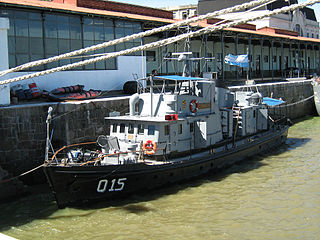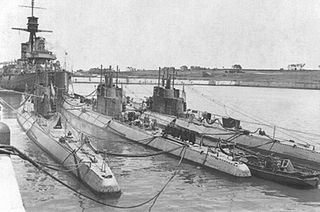
ARA Buenos Aires was the lead ship of her class of destroyer built for the Argentine Navy, in service from 1938 to 1971.

ARA Bahía San Blas is an amphibious cargo ship of the Argentine Navy, capable of unloading landing craft, troops, vehicles and cargo. She is the first Argentine Navy ship to bear the name of San Blas Bay of in the south of Buenos Aires Province.

ARA Patagonia was an armoured cruiser that served in the Argentine Navy between 1886 and 1927.

ARA La Argentina was a steam corvette that served as a training ship with the Argentine Navy between 1884 and 1895, and in other roles until decommissioned in 1899.

ARA Azopardo is a World War II era Argentine Navy warship, originally classified as patrol boat and later as antisubmarine frigate. The vessel is named after Juan Bautista Azopardo, an Argentine naval officer that served in both the Argentine War of Independence and in the Cisplatine War. It is the third Argentine naval ship with this name.

ARA Paraná was a steam and sail corvette built in United Kingdom in 1873 which served as a gunboat with the Argentine Navy between 1874 and 1899. It was decommissioned in 1900, converted to a transport and renamed Piedrabuena.

ARA Cormorán (Q-15) is a hydrographic survey boat of the Argentine Navy, built in the Río Santiago Shipyard and based in Buenos Aires. The vessel is named after the cormorant, a seabird that inhabits Argentina’s littoral, and is the fourth Argentine naval ship with this name.
ARA Petrel was a hydrographic survey boat of the Argentine Navy, built in the Cadenazzi Shipyard and based in Buenos Aires. The vessel is named after the petrel, a seabird that inhabits Argentina's littoral, and is the third Argentine naval ship with this name.

ARA Zurubí (P-55) is a patrol boat of the Argentine Navy, built in the Río Santiago Shipyard in 1938 and based in Ushuaia. The vessel is named after the Surubí, a catfish that inhabits Argentina’s Mesopotamia, and is the first Argentine naval ship with this name.
ARA Azopardo was a tugboat of the Argentine Navy, built in the Bethlehem Shipyard in 1919 and transferred to Argentina in 1922. It was based at the port of Buenos Aires and later at Puerto Belgrano, and was decommissioned in 1941. The vessel was named after the Juan Bautista Azopardo, a Maltese privateer and officer of the Argentine Navy during the Independence and Cisplatine wars, and was the second Argentine naval ship with this name.
ARA Azopardo was a steam transport of the Argentine Navy, built in the Stabilimento Tecnico Triestino and sold to Argentina in 1884. It was based, among others, in the port of Buenos Aires and later Ushuaia, and was decommissioned in 1922 after being sunk in an accident; it was refloated and sunk in 1924 as a target. The vessel was named after the Juan Bautista Azopardo, a Maltese privateer and officer of the Argentine Navy during the Independence and Cisplatine wars, and was the first Argentine naval ship with this name.

The Santa Fe-class submarines, also known as the Tarantinos after the city in which they were built, were a class of three pre-World War II submarines, designed and built in Italy in 1928-1933, as part of an Argentine expansion plan for its navy. They were in service with the Argentine Navy from the early 1930s to the late 1950s. The class was named after Argentine provinces starting with “S”, as traditional in the Argentine Navy.

ARA Cabo de Hornos (B-5) was a cargo ship in service with the Argentine Navy since 1979, capable of transporting bulk cargo, live cattle, and containers. She was the second ship in the Argentine Navy to bear the name of the Cape Horn (Chile) located to the south of Tierra del Fuego.

ARA Canal Beagle (B-3) is a cargo ship in service with the Argentine Navy since 1978, capable of transporting bulk cargo, live cattle, and containers. She is the second ship in the Argentine Navy to bear the name of the Beagle Channel in the south of Tierra del Fuego.

The Costa Sur-class cargo ship is a class of three cargo ships designed and built in Argentina in 1975–1979 for servicing the Patagonic coast routes; capable of transporting bulk cargo, live cattle, and containers. The ships have been in service with the Argentine Navy since 1978. The class is named after the southern coastal area of Argentina which was designed to service.
ARA Ingeniero Julio Krause (B-13) was an oil tanker ship in service with the Argentine Navy from 1993 to 2015, and with YPF from to 1981 to 1993. She was the first ship in the Argentine Navy to bear the name of Argentine engineer Julio Krause, who discovered oil in Comodoro Rivadavia in 1907.
ARA Punta Médanos (B-18) was an auxiliary ship of the Argentine Navy, a tanker built at the Swan, Hunter & Wigham Richardson shipyard, Wallsend, in 1950. While in naval service she made several commercial trips supplementing the YPF tanker fleet, and supported the high seas fleet; in this capacity Punta Médanos participated in the Falklands War in 1982. She was decommissioned in 1984 and sold for scrapping. The vessel was named after the coastal feature of Punta Médanos, Argentina, and was the first Argentine naval ship with this name.
ARA Luisito (Q-51) is a training ship of the Argentine Navy, in service since 1985 and based in Mar del Plata; where she is used to train students from Argentina’s National Fishing School. The vessel is the first Argentine naval ship with this name.











